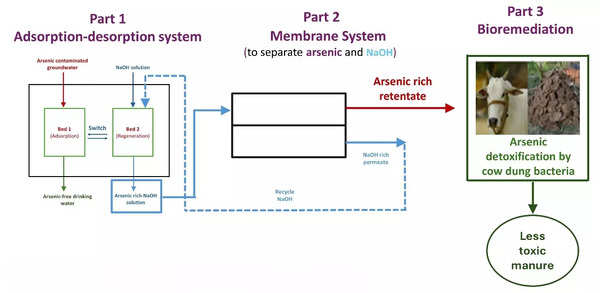Researchers at IISc’s Centre for Sustainable Technologies (CST) have developed this novel remediation process. The three-step method, which is patent-pending, also ensures that the removed heavy metals are disposed of in an environment-friendly and sustainable manner, instead of sending untreated heavy metal-rich sludge to landfills from where they can potentially re-enter groundwater.
“In every technology that exists, you can take out arsenic and provide clean water.However, after you remove the arsenic, you must do something about it so that it doesn’t re-enter the environment, and that aspect is not given due consideration in existing methods. Our process was designed to solve this problem,” says Yagnaseni Roy, assistant professor, CST.
Close-up view of the adsorbent beads. (Image: Sustainable Separation Solutions (S3) Lab, CST, IISc)
According to recent reports, groundwater in 113 districts across 21 Indian states has arsenic levels exceeding permissible limits, posing serious health risks to humans and animals. The IISc team’s method aims to tackle this pressing issue effectively.
“The first step of the process involves passing the contaminated water through a bed of chitosan-based adsorbent doped with iron and aluminium compounds. This bed captures the inorganic arsenic through electrostatic forces. Notably, the alkaline wash used to regenerate the adsorbent bed is recycled within the system,” IISc said.

Close-up view of the adsorbent beads. (Image: Sustainable Separation Solutions (S3) Lab, CST, IISc)
It added that in the second step, a membrane process separates the arsenic from the alkaline wash solution, concentrating the toxic metal for the next phase. The third and final step employs bioremediation, where microbes present in cow dung convert the highly toxic inorganic arsenic into less harmful organic forms through methylation.
“On average, these organic species are approximately 50 times less toxic than the inorganic form present in groundwater,” says Roy.
The remaining cow dung sludge containing the locked organic arsenic can be safely disposed of in landfills. The system is easy to assemble and operate, making it suitable for community-level implementation and maintenance by local residents.
Field trials of the pilot-scale system have been conducted in collaboration with NGOs in rural areas of Karnataka and Bihar. The researchers believe their cost-effective and sustainable solution could be scaled up to address arsenic contamination in various parts of the country with the necessary funding support.
“The collection of waste, maintenance and operation are easier on a community scale than individual houses. The maintenance is simple enough that it can be operated by people in the community itself, which will help with income generation for people operating the system,” says Rasmi Mohan T, PhD student at CST who has worked on the process.
“For a larger scale, we might need funding to take it to various parts of the country,” she added. Along with Roy and Mohan, master’s student Subhash Kumar and post-doctoral fellow Manamohan Tripathy have also been involved in developing this at both lab and pilot scales.
